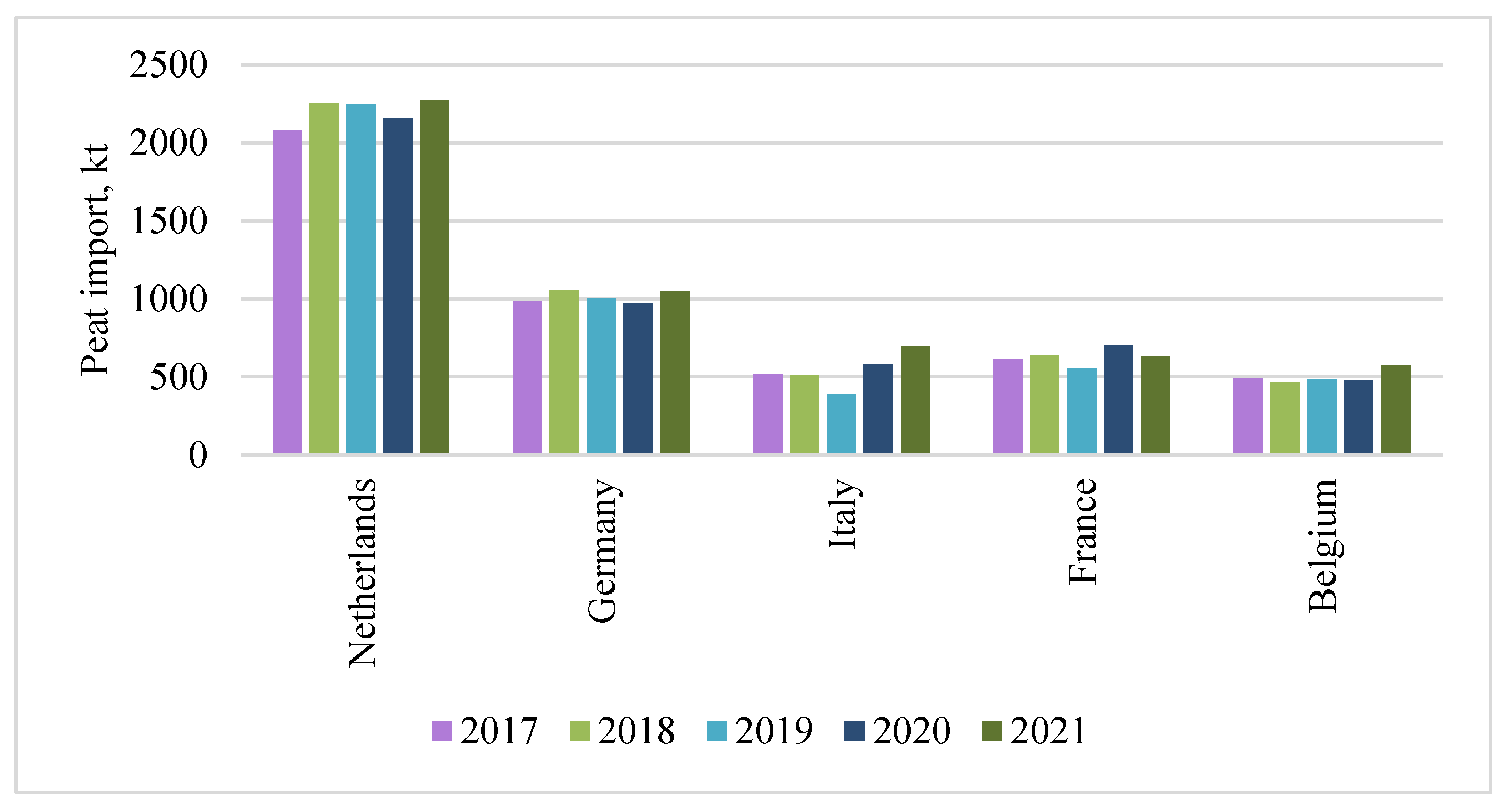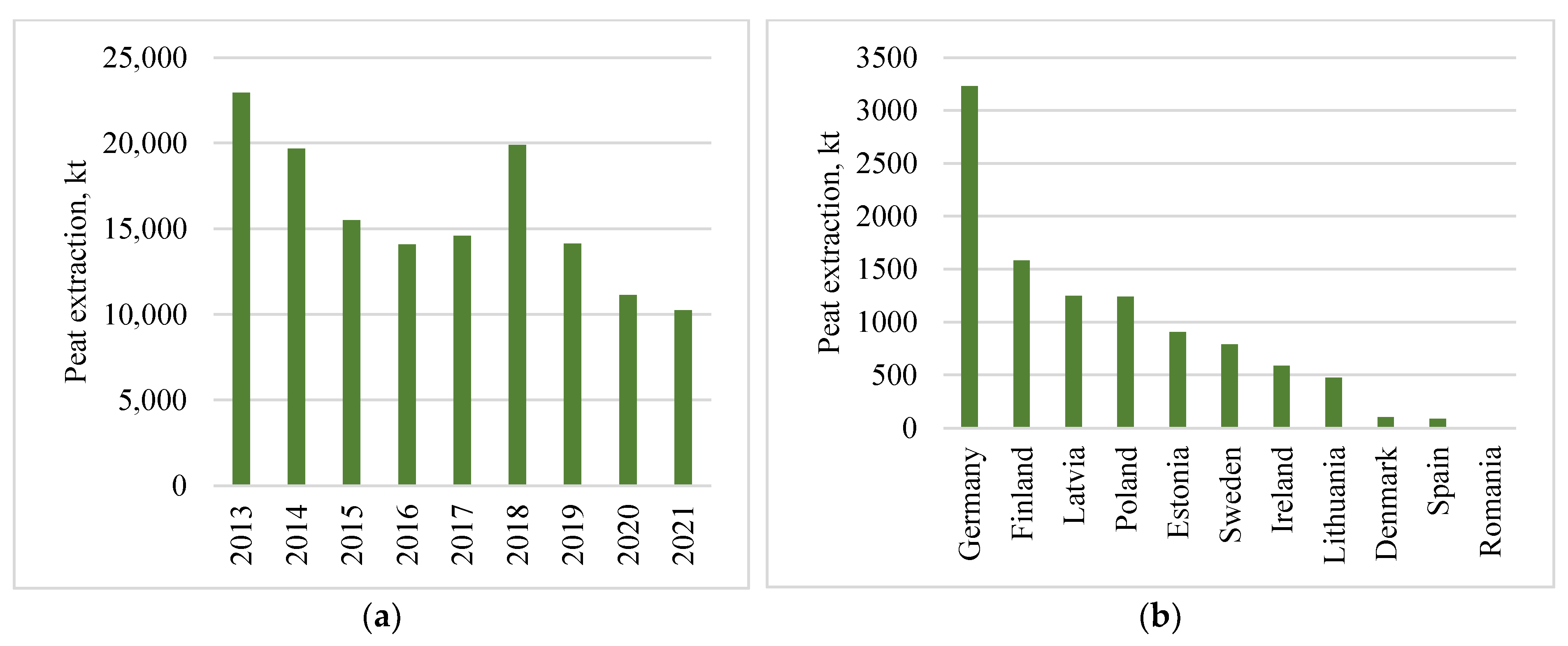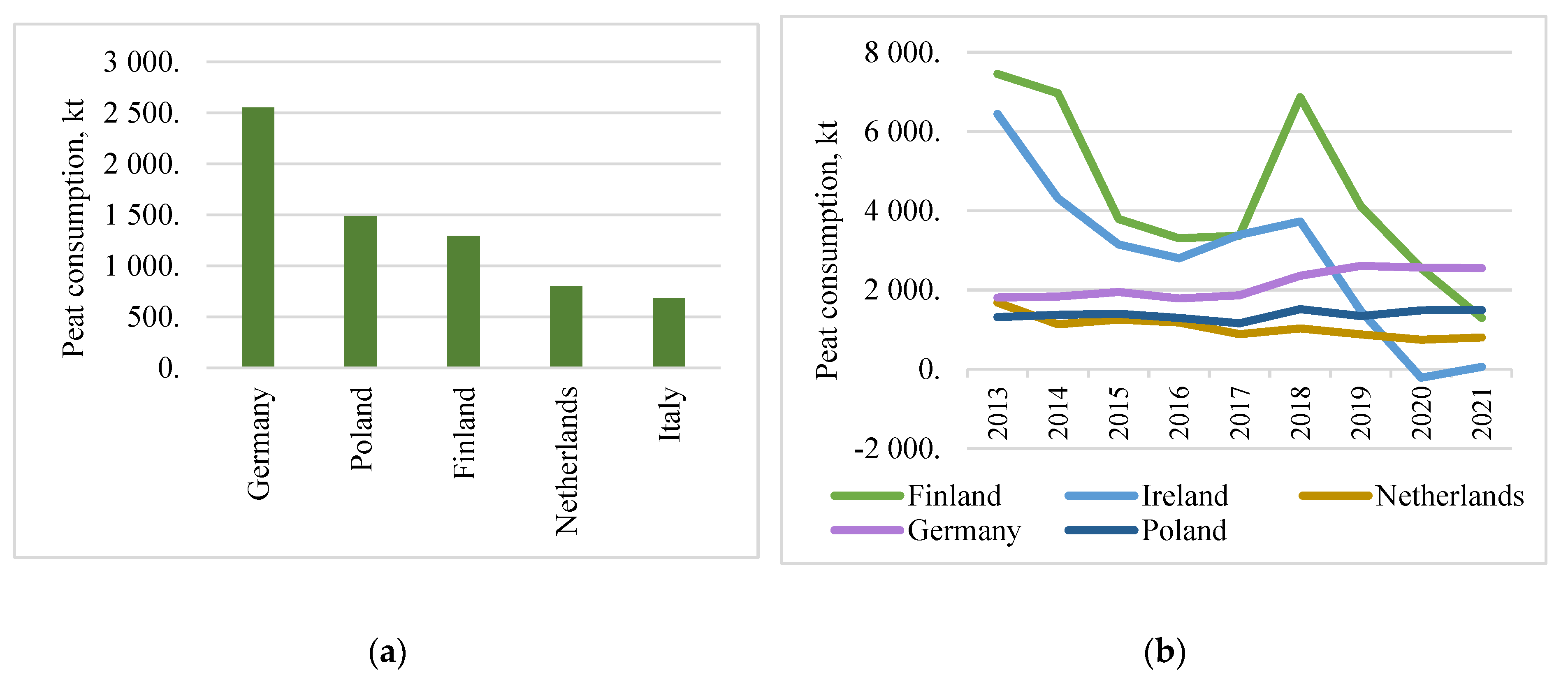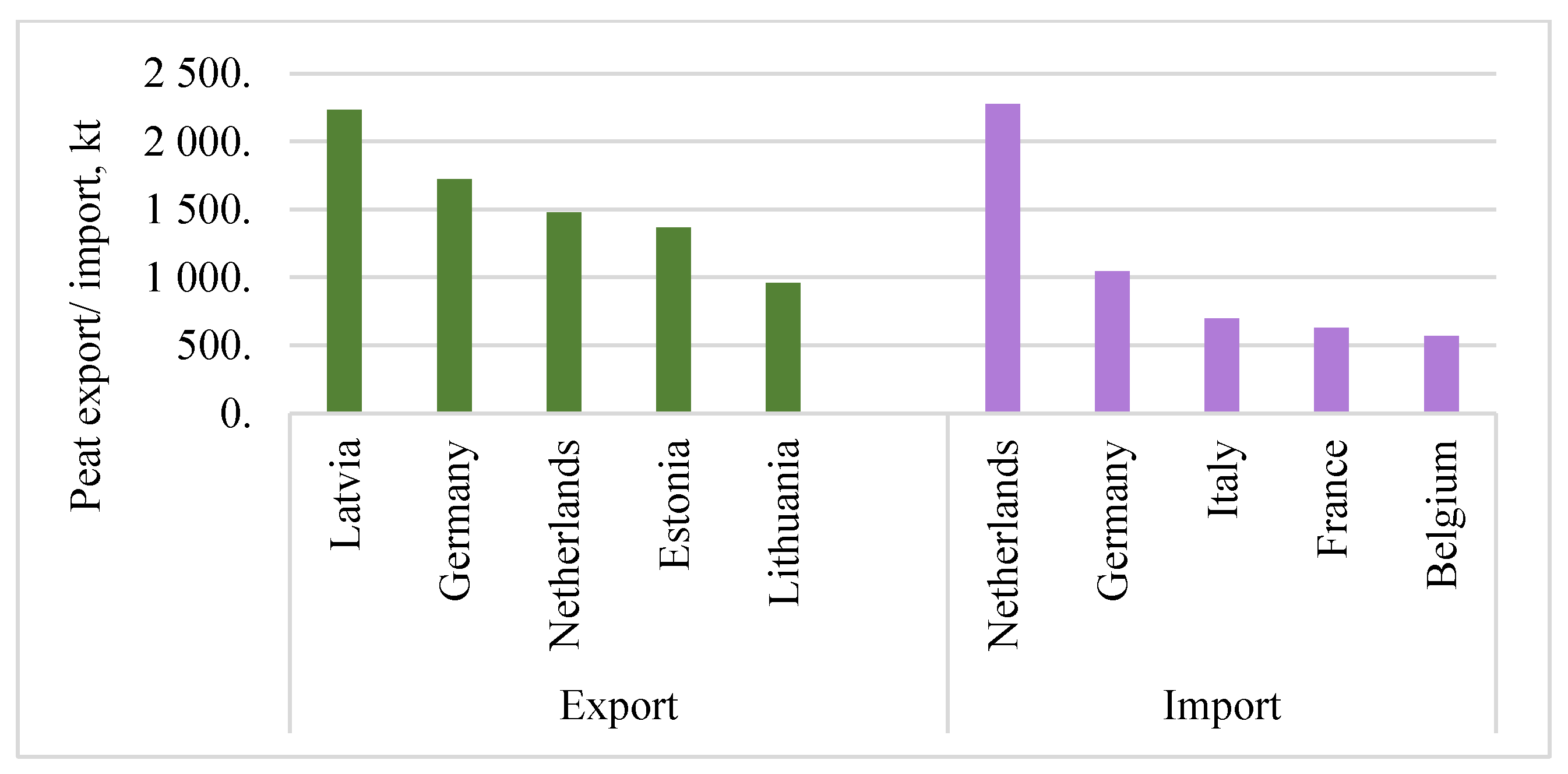Towards Resilient Peatlands: Integrating Ecosystem-Based Strategies, Policy Frameworks, and Management Approaches for Sustainable Transformation
Abstract
1. Introduction
2. Peatland Ecology, Distribution, and Degradation
2.1. Peatland Formation and Types
2.2. Peatland Distribution Degradation in Europe
3. Policy Framework for Peatland Management in Europe
3.1. EU Policy Initiatives for Peatland Restoration
- Protecting and restoring wetlands and peatlands;
- Enhancing ecosystem resilience;
- Developing green infrastructure;
- Sustainably managing farmlands and forests to mitigate emissions.
3.2. National and Regional Policy Approaches
3.3. Regulations on Peat Extraction
4. Extraction, Trade, and Application of Peat in the Horticulture and Energy Sector
4.1. Extraction and Market Dynamics of Peat

4.2. Peat Use in Horticulture and Energy Production
5. Challenges and Opportunities in Peatland Restoration
5.1. Key Challenges in Peatland Restoration
5.2. Restoration Strategies and Opportunities
5.3. Systems Approach to Peatland Management
- A reinforcing loop (“R”) that accelerates peatland degradation and climate change.
- A balancing loop (“B”) that attempts to counteract these effects through governance, restoration, and sustainable management.
6. Conclusions
Author Contributions
Funding
Institutional Review Board Statement
Informed Consent Statement
Data Availability Statement
Conflicts of Interest
References
- Maljanen, M.; Sigurdsson, B.D.; Guömundsson, J.; Öskarsson, H.; Huttunen, J.T.; Martikainen, P.J. Greenhouse Gas Balances of Managed Peatlands in the Nordic Countries Present Knowledge and Gaps. Biogeosciences 2010, 7, 2711–2738. [Google Scholar] [CrossRef]
- Grzybowski, M.; Glińska-Lewczuk, K. The Principal Threats to the Peatlands Habitats, in the Continental Bioregion of Central Europe—A Case Study of Peatland Conservation in Poland. J. Nat. Conserv. 2020, 53, 125778. [Google Scholar] [CrossRef]
- Tanneberger, F.; Moen, A.; Barthelmes, A.; Lewis, E.; Miles, L.; Sirin, A.; Tegetmeyer, C.; Joosten, H. Mires in Europe—Regional Diversity, Condition and Protection. Diversity 2021, 13, 381. [Google Scholar] [CrossRef]
- Hirschler, O.; Osterburg, B. Peat Extraction, Trade and Use in Europe: A Material Flow Analysis. Mires Peat 2022, 28, 1–27. [Google Scholar] [CrossRef]
- Leng, L.Y.; Ahmed, O.H.; Jalloh, M.B. Brief Review on Climate Change and Tropical Peatlands. Geosci. Front. 2019, 10, 373–380. [Google Scholar] [CrossRef]
- Montanarella, L.; Jones, R.J.A.; Hiederer, R. The Distribution of Peatland in Europe. Mires Peat 2006, 1, 1. [Google Scholar]
- Joosten, H. Global Guidelines for Peatland Rewetting and Restoration VoCo-Vorpommern Connect-Designing and Evaluating Sustainable Urban-Rural Value Chains View Project WETSCAPES View Project; Ramsar Convention Secretariat: Gland, Switzerland, 2021. [Google Scholar]
- Xu, J.; Morris, P.J.; Liu, J.; Holden, J. PEATMAP: Refining Estimates of Global Peatland Distribution Based on a Meta-Analysis. Catena 2018, 160, 134–140. [Google Scholar] [CrossRef]
- van Diggelen, R. Mires and Peatlands of Europe: Status, Distribution and Conservation. Restor. Ecol. 2018, 26, 1005–1006. [Google Scholar] [CrossRef]
- United Nations Environment Programme. UNEP Global Peatlands Assessment: The State of the World’s Peatlands—Evidence for Action Toward the Conservation, Restoration, and Sustainable Management of Peatlands; United Nations Environment Programme: Washington, DC, USA, 2022. [Google Scholar]
- Rochefort, L.; Andersen, R. Global Peatland Restoration after 30 Years: Where Are We in This Mossy World? Restor. Ecol. 2017, 25, 269–270. [Google Scholar] [CrossRef]
- Price, J.S.; Schlotzhauer, S.M. Importance of Shrinkage and Compression in Determining Water Storage Changes in Peat: The Case of a Mined Peatland. Hydrol. Process. 1999, 13, 2591–2601. [Google Scholar] [CrossRef]
- Peters, J.; von Unger, M. Peatlands in the EU Regulatory Environment Survey with Case Studies on Poland and Estonia; Federal Agency for Nature Conservation: Bonn, Germany, 2017; ISBN 9783896241917. [Google Scholar]
- LEGMC. Available online: http://www.latvijaskudra.lv/en/statistika/krajumi_un_ieguve/ (accessed on 11 August 2023).
- Agreement, P.; Directive, W.F. Policy Brief: Peatland Strategies in Europe. In Peatland Strategies in Europe; Bundesamt für Naturschutz: Bonn, Germany, 2020. [Google Scholar]
- European Union: European Commission. European Commission Accompanying the Document Proposal for a REGULATION OF THE EUROPEAN PARLIAMENT AND OF THE COUNCIL on European Data Governance (Data Governance Act); European Union: European Commission: Brussels, Belgium, 2020. [Google Scholar]
- Klauser, D.; Negra, C.; Torabi, N.; Torabi, N.; Ballard; Verschuuren, J.; Wongpiyabovorn, O.; Plastina, A.; Crespi, J.M.; Tidgren, K.A.; et al. Cornhusker Economics World. Land Use Policy 2021, 1. [Google Scholar]
- European Union Regulation 2016/679 of the European Parliament and the Council of the European Union. Off. J. Eur. Communities 2016.
- European Commission. Regulation of the European Parliament and of the Council on Nature Restoration. In Proceedings of the European Commission Proposal; European Commission: Luxembourg, 23 February 2022; Volume 2022/0195. [Google Scholar]
- European Parliament’s EU Nature Restoration Law Draft a Good Basis but Needs Stronger Peatland Measures. Available online: https://europe.wetlands.org/news/european-parliaments-eu-nature-restoration-law-draft-a-good-basis-but-needs-stronger-Peatland-measures/ (accessed on 8 March 2024).
- MEPs Push EU Nature Restoration Law Past Final Hurdle. Available online: https://www.farmersjournal.ie/news/news/meps-push-eu-nature-restoration-law-past-final-hurdle-806887 (accessed on 8 March 2024).
- Greifswald Mire Centre. Protecting and Restoring Peatlands-Targets and Recommendations for Peatlands in the EU Biodiversity Strategy; Greifswald Mire Centre: Greifswald, Germany, 2021. [Google Scholar]
- Zak, D.; McInnes, R.J. A Call for Refining the Peatland Restoration Strategy in Europe. J. Appl. Ecol. 2022, 59, 2698–2704. [Google Scholar] [CrossRef]
- Hirschler, O.; Osterburg, B. Peat Use, Climate Impacts and Mitigation Policies in Europe. In Proceedings of the 16th International Peatland Congress, Tallin, Estonia, 3–6 May 2021; pp. 89–94. [Google Scholar]
- Nordbeck, R.; Hogl, K. National Peatland Strategies in Europe: Current Status, Key Themes, and Challenges. Reg. Environ. Change 2024, 24, 5. [Google Scholar] [CrossRef]
- IndexBox EU: Peat Market 2022. Available online: https://www.indexbox.io/store/eu-peat-market-report-analysis-and-forecast-to-2020/ (accessed on 23 October 2023).
- TrendEconomy Annual International Trade Statistics by Country. Available online: https://trendeconomy.com/data/h2/EuropeanUnion/2703 (accessed on 23 October 2023).
- Joosten, H.; Tapio-Biström, M.-L.; Tol, S. Peatlands—Guidance for Climate Change Mitigation Through Conservation, Rehabilitation and Sustainable Use; Mitigation of Climate Change in Agriculture, Series; Food and Agriculture Organization (FAO): Rome, Italy; Wetlands International: Ede, The Netherlands, 2012. [Google Scholar]
- Chow, A. Carbon Credits from Peatland Rewetting, Climate—Biodiversity—Land Use. Soil Sci. Soc. Am. J. 2012, 76, 2342. [Google Scholar] [CrossRef]
- Bonn, A.; Allott, T.; Evans, M.; Joosten, H.; Stoneman, R. Peatland Restoration and Ecosystem Services: Science, Policy and Practice; Cambridge University Press: Cambridge, UK, 2016. [Google Scholar]
- Günther, A.; Barthelmes, A.; Huth, V.; Joosten, H.; Jurasinski, G.; Koebsch, F.; Couwenberg, J. Prompt Rewetting of Drained Peatlands Reduces Climate Warming despite Methane Emissions. Nat. Commun. 2020, 11, 1644. [Google Scholar] [CrossRef]
- Spiliopoulou, K.; Brooks, T.M.; Dimitrakopoulos, P.G.; Oikonomou, A.; Karavatsou, F.; Stoumboudi, M.T.; Triantis, K.A. Protected Areas and the Ranges of Threatened Species: Towards the EU Biodiversity Strategy 2030. Biol. Conserv. 2023, 284, 110166. [Google Scholar] [CrossRef]
- Kitir, N.; Yildirim, E.; Şahin, Ü.; Turan, M.; Ekinci, M.; Ors, S.; Kul, R.; Ünlü, H.; Ünlü, H. Peat Use in Horticulture. In Peat; IntechOpen: Rijeka, Croatia, 2018. [Google Scholar] [CrossRef]
- Schmilewski, G. The Role of Peat in Assuring the Quality of Growing Media. Mires Peat 2008, 3, 1–8. [Google Scholar]
- Joosten, H.; Clarke, D. Wise Use of Mires and Peatlands; International Peat Society: Saarijarvi, Finland, 2002; ISBN 9519774483. [Google Scholar]
- Hirschler, O.; Osterburg, B.; Weimar, H.; Glasenapp, S.; Ohmes, M.-F. Peat Replacement in Horticultural Growing Media: Availability of Bio-Based Alternative Materials; Thünen Working Paper, No. 190; Johann Heinrich von Thünen Institute, Federal Research Institute for Rural Areas, Forestry and Fisheries: Braunschweig, Germany, 2022. [Google Scholar]
- Altmann, M. Socio-Economic Impact of the Peat and Growing Media Industry on Horticulture in the EU. In Peat in Horticulture; European Peat and Growing Media Association (EPAGMA): Saterland-Sedelsberg, Germany, 2008; p. 134. [Google Scholar]
- Schmilewski, G. Growing Media Constituents Used in the EU in 2013. Acta Hortic. 2017, 1168, 85–92. [Google Scholar] [CrossRef]
- Taparia, T.; Hendrix, E.; Nijhuis, E.; de Boer, W.; van der Wolf, J. Circular Alternatives to Peat in Growing Media: A Microbiome Perspective. J. Clean. Prod. 2021, 327, 129375. [Google Scholar] [CrossRef]
- Verhagen, J.; Diemont, H.; Boon, H.; Silvius, M. Enhancing the Sustainability of the Peat Supply Chain for Dutch Horticulture. Acta Hortic. 2013, 982, 93–97. [Google Scholar] [CrossRef]
- Bos, M.G.; Diemont, W.H.; Verhagen, A. Sustainable Peat Supply Chain: Report of the Ad Hoc Working Group Enhancing the Sustainability of the Peat Supply Chain for the Dutch Horticulture; Alterra Report 2167; Alterra: Wageningen, The Netherlands, 2011; p. 126. [Google Scholar]
- Andersen, R.; Farrell, C.; Graf, M.; Muller, F.; Calvar, E.; Frankard, P.; Caporn, S.; Anderson, P. An Overview of the Progress and Challenges of Peatland Restoration in Western Europe. Restor. Ecol. 2017, 25, 271–282. [Google Scholar] [CrossRef]
- Gerding, M.A.W.; Karel, E.H.K.; de Vries, G.E. The History of the Peat Manufacturing Industry in The Netherlands: Peat Moss Litter and Active Carbon. Mires Peat 2015, 16, 1–9. [Google Scholar]
- Lempinen, H.; Vainio, A. Lost in Transition: Peat Workers’ Experiences of Finland’s Low Carbon Transition Policies. Extr. Ind. Soc. 2023, 15, 101312. [Google Scholar] [CrossRef]
- Schilstra, A.J. How Sustainable Is the Use of Peat for Commercial Energy Production? Ecol. Econ. 2001, 39, 285–293. [Google Scholar] [CrossRef]
- Ranta, T.; Karhunen, A.; Laihanen, M. Schedule for Reducing the Use of Peat and the Possibilities of Replacing It with Forest Chips in Energy Production in Finland. J. Sustain. Bioenergy Syst. 2022, 12, 99–115. [Google Scholar] [CrossRef]
- Statistics Finland. Energy in Finland; Statistics Finland: Helsinki, Finland, 2022. [Google Scholar]
- SEAI. Energy in Ireland 2022; SEAI: Dublin, Ireland, 2022. [Google Scholar]
- Country Report—Ireland 2022; European Commission: Brussels, Belgium, 2022.
- Eakins, J.; Sirr, G.; Power, B. Informally Sourced Solid Fuel Use: Examining Its Extent and Characteristics of the Users in the Residential Sector in Ireland. Energy Policy 2023, 172, 113293. [Google Scholar] [CrossRef]
- Barrett, G.E.; Alexander, P.D.; Robinson, J.S.; Bragg, N.C. Achieving Environmentally Sustainable Growing Media for Soilless Plant Cultivation Systems—A Review. Sci. Hortic. 2016, 212, 220–234. [Google Scholar] [CrossRef]
- Blok, C.; Eveleens, B.; van Winkel, A. Growing Media for Food and Quality of Life in the Period 2020–2050. Acta Hortic. 2021, 1305, 341–355. [Google Scholar] [CrossRef]
- Caron, J.; Rochefort, L. Use of Peat in Growing Media: State of the Art on Industrial and Scientific Efforts Envisioning Sustainability. Acta Hortic. 2013, 982, 15–22. [Google Scholar] [CrossRef]
- Lanzi, A.; Incroccia, L.; Pulizzi, R.; Pardossi, A.; Marzialetti, P. Evaluation of Some Peat-Alternative Substrates in Horticultural Crops. Acta Hortic. 2009, 807, 553–558. [Google Scholar] [CrossRef]
- Hirschler, O.; Thrän, D. Peat Substitution in Horticulture: Interviews with German Growing Media Producers on the Transformation of the Resource Base. Horticulturae 2023, 9, 919. [Google Scholar] [CrossRef]
- Halme, P.; Allen, K.A.; Auniņš, A.; Bradshaw, R.H.W.; Brumelis, G.; Čada, V.; Clear, J.L.; Eriksson, A.M.; Hannon, G.; Hyvärinen, E.; et al. Challenges of Ecological Restoration: Lessons from Forests in Northern Europe. Biol. Conserv. 2013, 167, 248–256. [Google Scholar] [CrossRef]
- Martin, N.N. Organic Soils in National Inventory Submissions of EU Countries. Master’s Thesis, Greifswald Mire Centre, Greifswald, Germany, 2021. [Google Scholar]
- Trepel, M. Evaluation of the Implementation of a Goal-Oriented Peatland Rehabilitation Plan. Ecol. Eng. 2007, 30, 167–175. [Google Scholar] [CrossRef]
- Bain, C.G.; Bonn, A.; Stoneman, R.; Chapman, S.; Coupar, A.; Evans, M.; Gearey, B.; Howat, M.; Joosten, H.; Keenleyside, C.; et al. IUCN UK Commission of Inquiry on Peatlands; United Kingdom National Committee of IUCN Members: London, UK, 2011. [Google Scholar]
- Anna-Helena Purre Conference and Workshop on Good Practices in Peatland Restoration; Riga. 2023. Available online: https://www.vidzeme.lv/wp-content/uploads/2023/11/JTP_Conference_Draft_Agenda_29_November_update.pdf (accessed on 2 November 2024).
- Darusman, T.; Murdiyarso, D.; Impron; Anas, I. Effect of Rewetting Degraded Peatlands on Carbon Fluxes: A Meta-Analysis. Mitig. Adapt. Strateg. Glob. Change 2023, 28, 10. [Google Scholar] [CrossRef]
- Jurasinski, G.; Byrne, K.; Chojnicki, B.H.; Christiansen, J.R.; Huth, V.; Joosten, H.; Juszczak, R.; Juutinen, S. Active Afforestation of Drained Peatlands Is Not a Viable Option Under the EU Nature Restoration Law. Available online: https://wwfcee.org/uploads/nature%20restoration%20law/Letter_Afforestation_on_peatland.pdf (accessed on 2 November 2024).
- Priede, A.; Gancone, A.; Bebre, I.; Bukovska, I.; Celma, S.; Kasakovskis, A.; Makovskis, K.; Neimane, S.; Nusbaums, J.; Okmanis, M.; et al. Sustainable and Responsible After-Use of; Priede, A., Gancone, A., Eds.; Baltijas Krasti: Riga, Latvia, 2019; ISBN 9789934198458. [Google Scholar]
- Surahman, A.; Shivakoti, G.P.; Soni, P. Climate Change Mitigation through Sustainable Degraded Peatlands Management in Central Kalimantan, Indonesia. Int. J. Commons 2019, 13, 856–866. [Google Scholar] [CrossRef]
- Li, Q.; Gogo, S.; Leroy, F.; Guimbaud, C.; Laggoun-Défarge, F. Response of Peatland CO2 and CH4 Fluxes to Experimental Warming and the Carbon Balance. Front. Earth Sci. 2021, 9, 631368. [Google Scholar] [CrossRef]
- Abdalla, M.; Hastings, A.; Truu, J.; Espenberg, M.; Mander, Ü.; Smith, P. Emissions of Methane from Northern Peatlands: A Review of Management Impacts and Implications for Future Management Options. Ecol. Evol. 2016, 6, 7080–7102. [Google Scholar] [CrossRef]
- Renou-Wilson, F.; Moser, G.; Fallon, D.; Farrell, C.A.; Müller, C.; Wilson, D. Rewetting Degraded Peatlands for Climate and Biodiversity Benefits: Results from Two Raised Bogs. Ecol. Eng. 2019, 127, 547–560. [Google Scholar] [CrossRef]
- Peatlands and Climate in a Ramsar Context; Nordic Council of Ministers: Copenhagen, Denmark, 2015.
- Grootjans, A.P. Paludiculture—Productive Use of Wet Peatlands. Restor. Ecol. 2017, 25, 661–663. [Google Scholar] [CrossRef]









Disclaimer/Publisher’s Note: The statements, opinions and data contained in all publications are solely those of the individual author(s) and contributor(s) and not of MDPI and/or the editor(s). MDPI and/or the editor(s) disclaim responsibility for any injury to people or property resulting from any ideas, methods, instructions or products referred to in the content. |
© 2025 by the authors. Licensee MDPI, Basel, Switzerland. This article is an open access article distributed under the terms and conditions of the Creative Commons Attribution (CC BY) license (https://creativecommons.org/licenses/by/4.0/).
Share and Cite
Patel, N.; Ieviņa, B.; Kažmēre, D.; Feofilovs, M.; Kamenders, A.; Romagnoli, F. Towards Resilient Peatlands: Integrating Ecosystem-Based Strategies, Policy Frameworks, and Management Approaches for Sustainable Transformation. Sustainability 2025, 17, 3419. https://doi.org/10.3390/su17083419
Patel N, Ieviņa B, Kažmēre D, Feofilovs M, Kamenders A, Romagnoli F. Towards Resilient Peatlands: Integrating Ecosystem-Based Strategies, Policy Frameworks, and Management Approaches for Sustainable Transformation. Sustainability. 2025; 17(8):3419. https://doi.org/10.3390/su17083419
Chicago/Turabian StylePatel, Nidhiben, Baiba Ieviņa, Dita Kažmēre, Maksims Feofilovs, Agris Kamenders, and Francesco Romagnoli. 2025. "Towards Resilient Peatlands: Integrating Ecosystem-Based Strategies, Policy Frameworks, and Management Approaches for Sustainable Transformation" Sustainability 17, no. 8: 3419. https://doi.org/10.3390/su17083419
APA StylePatel, N., Ieviņa, B., Kažmēre, D., Feofilovs, M., Kamenders, A., & Romagnoli, F. (2025). Towards Resilient Peatlands: Integrating Ecosystem-Based Strategies, Policy Frameworks, and Management Approaches for Sustainable Transformation. Sustainability, 17(8), 3419. https://doi.org/10.3390/su17083419






